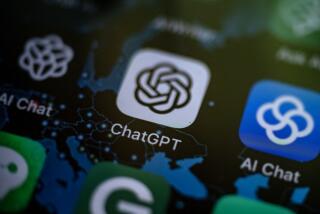Telemedicine means caregivers are remote, but their care isn’t
- Share via
It sounds futuristic, but telemedicine — the use of telecommunications technologies to diagnose and treat patients — has been hotly anticipated at least since 1993, when the American Telemedicine Assn. was established.
But in the last two years, it has finally “taken off” thanks to better technology and lower costs, says Jim Linkous, the association’s CEO. “Today 20 million Americans get some part of their health care remotely,” and that number will grow as telemedicine will expand its reach, he says.
Here’s a sampling of ways it’s being used now and a preview of what’s to come.
Behind-the-scenes telemedicine
A lot of telemedicine goes on outside of a doctor’s office, where patients can’t see it. Anyone getting an CT scan, for example, may assume the radiologist who reads it is just across the hall. But she could be across town, in another state or even in another country.
Do-it-yourself telemedicine
Use your smartphone to take a picture of the rash on your arm and email it to your doctor for a diagnosis. Not only will you save yourself an office visit, but you’ll be collaborating on a little telemedicine.
These days, it’s common for patients with chronic diseases to keep tabs on themselves with monitoring equipment that measures stats like blood pressure, blood sugar and temperature and then sends the data to healthcare providers via a phone line.
A 2010 report by Kalorama Information estimated that the market for remote patient monitoring technology would increase by 26% a year through 2014. Another 2010 report by Juniper Research predicted that remote patient monitoring would save healthcare providers about $2 billion to $6 billion by 2014.
Videoconferencing
Some hospitals can’t afford to have every sort of specialist on staff. But patients can still get treatment from them via videoconferencing.
Consider, for example, the Ronald Reagan UCLA Medical Center TeleStroke Network Partner Program.
The sooner a stroke victim gets proper treatment, the more brain cells can be preserved. And within 15 minutes after arriving at any of the 15 network hospitals throughout California, a stroke victim will be connected via videoconference with a UCLA neurologist, says the program’s director, Dr. Latisha Ali.
“They can see us, and we can see them,” Ali says. “It’s almost like being there with them in person, except you can’t touch them.”
A videoconference exam, which can include the patient’s family, is highly interactive and much more reliable than getting a patient’s history over the phone, she says. “And it’s a very nice picture — HD. We can even evaluate pupils, see their reactions.”
In the near future, the greatest good may well come from increasing the number of hospitals that have tele-access to specialists. “Our own goal,” Ali says, “is to make sure any stroke patient that arrives at a hospital gets the care they need.”






